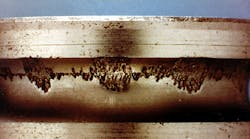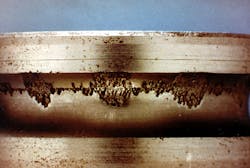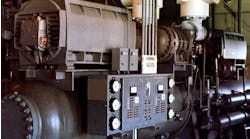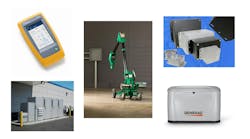When an electric motor will be stored a long time before being placed in service, you must take certain steps to ensure it will be suitable for operation when it’s needed. One practical limitation to recognize is that much of what is done when preparing a motor for long-term storage must be undone when it is moved into operation.
Storage procedures generally depend on the size of the motor and whether it will be out of service short term (several weeks) or long term (several months or years). These storage periods aren’t absolutes, so various practical considerations might call for different schedules. Likewise, factors such as heat, humidity, and vibration affect all motors, but it’s not always practical to protect smaller motors as diligently as larger ones.
Short-term storage
For motors that will be put in service within a few weeks, the main requirements are protection from ambient vibration (more on this later) and the weather. If possible, store motors indoors in a clean, dry area, placing horizontal machines in a horizontal position and vertical motors in a stable vertical position.
Unless the storage area is climate controlled, prevent condensation from forming inside the motor by energizing the space heaters (if supplied) to keep the windings 5°C to 10°C (10°F to 20°F) above the ambient temperature. (For other ways to prevent condensation, see discussion on special care for windings below.)
When outdoor storage is necessary, protect the motor with a waterproof cover (i.e., a tarp), allowing for a breathing space at the bottom. Wrapping it tightly in plastic and placing it in the sun will create a solar still — temperature extremes plus humidity will cause condensation inside the motor.
Outdoor storage also requires preventive measures to keep rodents, snakes, birds, or other small animals from entering the motor and damaging the winding insulation. In areas where insects are prevalent, keep them from blocking ventilation or drain openings by loosely wrapping the motor and covering all openings.
Long-term storage
Additional preparations are needed to protect the machined surfaces, bearings, and windings of above-NEMA size machines — and all other motors slated for long-term storage.
Shafts and machined surfaces. A viscous rust/corrosion inhibitor (e.g., LPS2, Techtyl 502C or RustVeto) should be applied to exposed machined surfaces and remain in place throughout the storage period. In humid and rainy/snowy environments, it’s good practice to have the service center paint as much of the motor’s interior surface as practical and to coat the windings with a topical fungicide in tropical environments. (Note: If sleeve bearing surfaces are coated, the machine must be dismantled to remove the coating before the motor is placed in service.)
Bearings — rust and corrosion. If long-term storage is expected, completely fill the bearing cavities of grease-lubricated motors with compatible grease to prevent rust and corrosion staining that can occur if moisture collects between the balls and races.
Oil-lubricated motors are shipped without oil. Fill the reservoir to maximum capacity after the motor has been situated in storage. If possible, add enough oil to cover the bearings completely, without overflowing the stand tube or labyrinth seal. The oil should contain a rust and corrosion inhibitor. Water is heavier than oil, so draw an oil sample from the drain to check for moisture at three-month intervals. Tip: Never move a motor with oil in the reservoir. If oil sloshes over the stand tube, the combination of surface tension and capillary action may continue to siphon oil from the chamber. Before putting the motor into service, always drain and replace the oil. (Drain it, move it, and then refill it.)
Bearings — ambient vibration. Motors can be damaged by vibration even when they aren’t rotating. Proximity to rail lines, busy roads, and/or production floors can all contribute to the ambient vibration. Even low-magnitude vibration, over time, can damage bearings while they’re stationary (e.g., false brinelling). One mill solved the problem of ambient vibration from nearby machinery by storing motors on worn out conveyor belting that otherwise was destined for a landfill.
False brinelling causes uniformly spaced damage along the bearing race that matches the spacing of the rolling elements. Although initially it may appear slight or even invisible to the naked eye, the damage often progresses rapidly when the motor is placed in service (see Photo). Corrosion staining can also result if moisture collects between the balls and races.
Shaft rotation. Motors in long-term storage should have the shaft rotated at least monthly to prevent false brinelling and inhibit corrosion by redistributing lubricant on machined surfaces. Larger, 2-pole machines require more frequent attention than smaller (NEMA-frame) machines.
In the case of machines with heavy rotors and long frames, regular rotation of the shaft is crucial to prevent shaft distortion caused by rotor sag. This is a consideration for machines rated approximately 1,500 hp (1,100kW) and larger, some of which may need rotation weekly. As an extreme example, power plants typically keep very large turbine generators rotating slowly at all times to prevent sag. While it’s uncommon, the rotors of very large critical machines can also be removed and suspended vertically to prevent sagging.
Tip: Stop the keyway in a different o’clock position each month. Rotating the shaft keyway position in 5-hour increments (with all shafts following the same rule) makes it easy to see if a motor was missed. For example, if the keyway position for September is 12:00, October will be 5:00, November will be 10:00, and so on. This puts the rolling elements in a different orientation each time and avoids rocking the rotor back and forth between just two positions.
Special care for windings. Motor windings must be kept clean and dry to prevent insulation degradation while the motor is in storage. If the storage area isn’t climate controlled, the winding temperature must be kept above the dew point to prevent condensation inside the motor. This is usually accomplished by keeping the winding 5°C to 10°C (10°C to 20°F) above the ambient temperature. Space heaters should be energized if they’re supplied (or added if they aren’t) while the motor is in storage. Another option is to supply low-voltage DC and use the windings as a resistance heater. Single-phase AC voltage (approximately 8% to 12% of rated) can be used instead of DC. Another alternative is to lower the dew point of the storage room with a dehumidifier.
Measure the insulation resistance (IR) of the winding(s) before putting the motor into storage. Even if the motor will be idle only a short time, at the very least it should be tested before it is placed in storage and just before it is put in service. That way, any decrease in the insulation resistance can be addressed before the motor is installed. If the motor will be stored a long time, take IR readings annually, correcting them to a standard temperature. Tip: Attach a card to each motor and record the IR, temperature, and date each time it is checked.
For form coil windings, conduct a polarization index (PI) test in addition to the IR test. The PI test variables skew results for windings with lots of exposed conductor surface area, so use the dielectric absorption ratio (DA) test for random windings and DC armatures (see Table).
If the windings need to be cleaned and dried, take IR and PI readings again before returning the motor to storage. Disregard the PI ratio if the IR is greater than 5,000 megohms (see IEEE 43).
Carbon brushes. DC machines, wound-rotor motors, and some synchronous machines are fitted with carbon brushes. For long-term storage, lift the brushes away from the commutator/slip rings to prevent a chemical reaction. Store the springs in the relaxed state, when practical, to avoid weakening them.
Placing the motor in service
To ensure proper operation when the motor is removed from storage and put in service, perform the following:
- Remove any dust or dirt and inspect the motor.
- Measure the IR with a megohmmeter, and compare the temperature-corrected reading with the one taken before the motor was placed in storage.
- Drain oil-lubricated motors before moving them to the installation site; refill the reservoir after installation.
- For grease-lubricated motors, purge any excess grease by running the motor at least 10 to 20 minutes with the drain plug removed.
- If there is any moisture in the grease, the bearings have probably sustained rust damage and should be replaced.
- If the motor was stored for several years, the grease has probably hardened, and the drainpipe will be plugged with dried grease. In that case, it’s best to dismantle the motor, clean out the old grease, and repack it with fresh grease.
- If the motor has been subject to vibration while in storage, inspect the bearings, and replace any that are damaged before installing the motor.
- After installing and aligning the motor, but before coupling it to the load, document uncoupled baseline vibration levels; check the vibration levels again after the motor has been in service a week or two.
- For motors with rolling element bearings, evaluate the vibration spectra for indications of bearing fault frequencies.
- For large machines where shaft sag is a consideration, performing vibration analysis during startup is critical to avoid catastrophic damage.
High-cost machines obviously justify more precautions than inexpensive, readily available motors. What’s not always apparent is that some “small” motors are equally important to production and can have enormous consequences if they fail.
To wrap up this discussion, let’s close with a light-hearted tip from an end-user who claimed to have solved his shaft rotation issues by storing motors along the walkway to the break room (shafts pointing toward the walkway) with a sign that read “DO NOT TURN SHAFTS!” He said all of the shafts were spun frequently, almost daily.
Yung is a senior technical support specialist at the Electrical Apparatus Service Association (EASA) in St. Louis. He can be reached [email protected].





